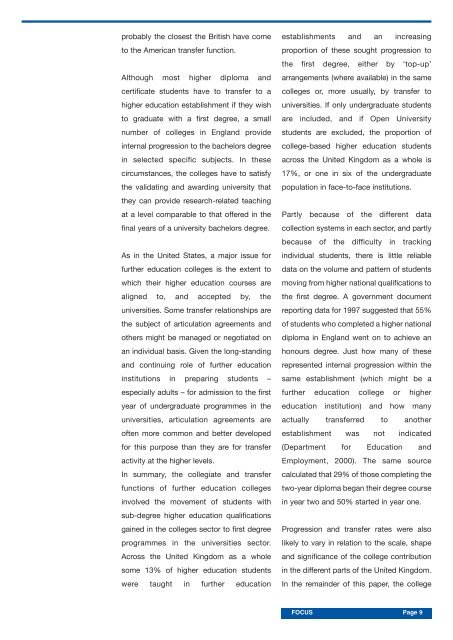Journal of Research & Scholarly Output 2006 - Grimsby Institute of ...
Journal of Research & Scholarly Output 2006 - Grimsby Institute of ...
Journal of Research & Scholarly Output 2006 - Grimsby Institute of ...
You also want an ePaper? Increase the reach of your titles
YUMPU automatically turns print PDFs into web optimized ePapers that Google loves.
probably the closest the British have come<br />
to the American transfer function.<br />
Although most higher diploma and<br />
certificate students have to transfer to a<br />
higher education establishment if they wish<br />
to graduate with a first degree, a small<br />
number <strong>of</strong> colleges in England provide<br />
internal progression to the bachelors degree<br />
in selected specific subjects. In these<br />
circumstances, the colleges have to satisfy<br />
the validating and awarding university that<br />
they can provide research-related teaching<br />
at a level comparable to that <strong>of</strong>fered in the<br />
final years <strong>of</strong> a university bachelors degree.<br />
As in the United States, a major issue for<br />
further education colleges is the extent to<br />
which their higher education courses are<br />
aligned to, and accepted by, the<br />
universities. Some transfer relationships are<br />
the subject <strong>of</strong> articulation agreements and<br />
others might be managed or negotiated on<br />
an individual basis. Given the long-standing<br />
and continuing role <strong>of</strong> further education<br />
institutions in preparing students –<br />
especially adults – for admission to the first<br />
year <strong>of</strong> undergraduate programmes in the<br />
universities, articulation agreements are<br />
<strong>of</strong>ten more common and better developed<br />
for this purpose than they are for transfer<br />
activity at the higher levels.<br />
In summary, the collegiate and transfer<br />
functions <strong>of</strong> further education colleges<br />
involved the movement <strong>of</strong> students with<br />
sub-degree higher education qualifications<br />
gained in the colleges sector to first degree<br />
programmes in the universities sector.<br />
Across the United Kingdom as a whole<br />
some 13% <strong>of</strong> higher education students<br />
were taught in further education<br />
establishments and an increasing<br />
proportion <strong>of</strong> these sought progression to<br />
the first degree, either by ‘top-up’<br />
arrangements (where available) in the same<br />
colleges or, more usually, by transfer to<br />
universities. If only undergraduate students<br />
are included, and if Open University<br />
students are excluded, the proportion <strong>of</strong><br />
college-based higher education students<br />
across the United Kingdom as a whole is<br />
17%, or one in six <strong>of</strong> the undergraduate<br />
population in face-to-face institutions.<br />
Partly because <strong>of</strong> the different data<br />
collection systems in each sector, and partly<br />
because <strong>of</strong> the difficulty in tracking<br />
individual students, there is little reliable<br />
data on the volume and pattern <strong>of</strong> students<br />
moving from higher national qualifications to<br />
the first degree. A government document<br />
reporting data for 1997 suggested that 55%<br />
<strong>of</strong> students who completed a higher national<br />
diploma in England went on to achieve an<br />
honours degree. Just how many <strong>of</strong> these<br />
represented internal progression within the<br />
same establishment (which might be a<br />
further education college or higher<br />
education institution) and how many<br />
actually transferred to another<br />
establishment was not indicated<br />
(Department for Education and<br />
Employment, 2000). The same source<br />
calculated that 29% <strong>of</strong> those completing the<br />
two-year diploma began their degree course<br />
in year two and 50% started in year one.<br />
Progression and transfer rates were also<br />
likely to vary in relation to the scale, shape<br />
and significance <strong>of</strong> the college contribution<br />
in the different parts <strong>of</strong> the United Kingdom.<br />
In the remainder <strong>of</strong> this paper, the college<br />
FOCUS Page 9

















